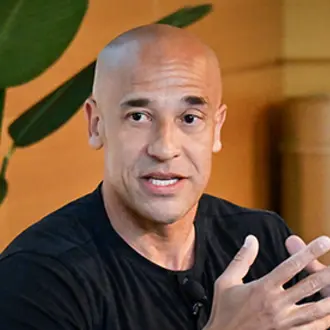On the second day of MIT Sloan Reunion 2023, attendees were treated to a discussion regarding burnout and moral injury in health care with MIT Sloan Physicians Group founders Andrea Doria, EMBA ’19, Anthony Dowidowicz, EMBA ’18, Jason Gluck, EMBA ’22, and Carl Dahlberg, SF ’17.
Anthony Dowidowicz, EMBA ’18
Credit: Barry HetheringtonBeginning the discussion, Dowidowicz, who is the executive medical director at Regence BlueCross BlueShield of Utah, explained that although burnout and moral injury affect all frontline workers, they decided to focus on physicians because “physicians are uniquely empowered and situated to do something about this on behalf of the entire health care system.”
Dowidowicz defined burnout as when someone has a failure of capacity, or when their capacity is overwhelmed. It responds to therapy and taking time away from work or diminishing one’s work burden overall. At the same time, burnout is hard to live with as it implies a personal failing; people start to wonder whether they are competent and what is wrong with them.
That said, Dowidowicz noted that “especially after the pandemic, which laid bare so many real, serious problems in American health care, we recognize that [burnout] really isn’t a personal failing. It’s the system overwhelming individuals who are trying to provide care.”
Moral injury, on the other hand, is caused by someone who is repeatedly forced to witness or act in ways that violate their moral code. While an isolated incident, referred to as moral distress, can be recovered from, moral injury is much more insidious.
Dahlberg, a clinical emergency physician and the principal of Dahlberg Healthcare Solutions, described moral injury as “progressively corrosive. People become disengaged, apathetic, and it causes a permanent change in the person.” Unlike burnout, moral injury is not a phenomenon that can be treated by taking time away from work. According to Dowidowicz, when faced with moral injury, what one needs is “active engagement and finding solutions.”
Doria, vice chair of radiology and clinical practice improvement at the University of Toronto, brought to attention that people are often ashamed to talk about their experiences with moral injury and burnout. They expect judgment on a personal and professional level and particularly avoid places that would document their problems, instead keeping things entirely to themselves or turning to WhatsApp groups with close colleagues and friends.
Andrea Doria, EMBA ’19
Credit: Barry HetheringtonWhen discussing examples of moral injury Gluck, system medical director at Hartford Healthcare, noted that one major issue is hospital capacity and payment procedures. Often one hospital will not have the capability of another, but the patient cannot be transferred because there is no place to put the patient, or the patient will be refused because they do not have the right insurance and the hospital is not guaranteed payment. That becomes a moral injury because, as Gluck explained, “we as an individual would love to take care of this person, agnostic to payment, but payment becomes an issue.”
Dahlberg’s examples of moral injury included discussing the failure of the behavioral health system, estimating that a third to a half of the beds in his emergency department are filled with people that have behavioral health problems, many of them children. He shared an experience he had of refusing to involuntarily sedate a young girl who was acting out at the potential risk of his own position, instead calming her down in a way that did not cause him further moral injury.
Dowidowicz spoke of how during the height of the pandemic he traveled to help people across the country who were struggling to provide health care. He was in a room entirely full of inexperienced nurses when he came to the realization that “the system really is broken.”
“We are not able to function and do our jobs and take care of the public in the way that we had imagined,” he continued. “It really is time for the corporate practice of medicine by private equity and venture capital to take a step back and embrace physician and clinical nursing leadership, and listen to what is actually going to work and give people quality health care.”
“We need to develop a culture [where] we understand that not being okay is okay, and not being ashamed of that,” Doria concluded at the end of the session. “This is something that we really need to look at with different eyes so that we can create this culture that takes care of each other. It’s very important to take care of our colleagues.”



